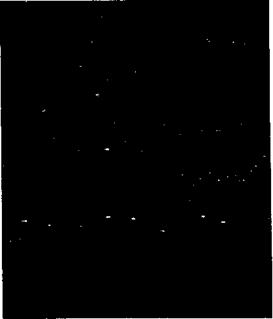Density Gradient Methods
A fundamental requirement for the successful application of density gradient methods of flow visualization such as schlieren or shadowgraphy is that the flow contain regions with significant density inhomogeneities. Because the refractive index of air is directly proportional to its density, planes with density variations in the flow field cause incident light rays normal to these planes to be refracted. Using a cutoff or other device, the angular deflection of the light rays gives a schlieren effect. If the rays are directly cast onto a projection screen, this will result in a shadowgram or shadowgraph. While shock waves and acoustic waves are readily visualized with density gradient techniques, it is not always appreciated that the flow near rotor tip vortices will also produce large enough compressibility effects. However, to achieve such effects with subscale rotors, the tip speeds must be at or close to full-scale values, and the rotor must be operated at relatively high rotor thrust and blade loading coefficients to generate strong vortices. General overviews of density gradient techniques of flow visualization are given by Holder & North (1963) and Merzkirch (1981).
Walters & Skujins (1972), Tangier et al. (1973), Tangier (1977), and Moedersheim et al. (1994) have used strobed schlieren techniques to observe the tip vortices generated by subscale rotors. An example of Tangier’s work is shown in Fig. 10.3, where the tip
|
Figure 10.3 Strobed schlieren visualization of part of the wake formed by a subscale rotor during hovering flight. Source: Tangier (1977) and courtesy of James Tangier. |
 |
Figure 10.4 Visualization of a tip vortex filament inside a rotor wake by means of wide – field shadowgraphy. Source: University of Maryland.
vortices can be clearly seen. .Tangier (1977) also shows that various 3-D acoustic wave phenomena generated by the rotor can be rendered visible with schlieren. A limitation with schlieren, however, is the small field of view because of the need to use high-quality, aberration-free, focusing mirrors. Direct shadowgraphy uses no mirrors and so allows a much larger field and angle of view. However, because of the relatively weak density gradients found in rotor vortices, a shadowgraph screen must be made of a high-efficiency retroreflective material to give sufficient contrast to allow the image to be recorded on photographic film – see Moedersheim et al. (1994) and Winbum et al. (1996). Parthasarthy et al. (1985), Norman & Light (1987), Light et al. (1990), Bagai & Leishman (1992a, b), Swanson (1993), and Lorber et al. (1994) have successfully used strobed shadowgraphy to study tip vortex formation, blade vortex interactions, and rotor wake-airframe interaction phenomena. By taking advantage of the axial symmetry of the wake in hover, shadowgraphy can also allow the quantitative displacements of the tip vortices relative to the rotor to be obtained as a function of wake age – see Norman & Light (1987) and Bagai & Leishman (1992b).
Figure 10.4 shows an example of a strobed shadowgraph detailing the flow immediately surrounding a tip vortex. This image was captured using a modified wide field-of-view shadowgraph system, incorporating a beam splitter arrangement – see Bagai & Leishman (1992a). This simple adaptation of the basic wide-field shadowgraph technique allows on – axis viewing and maximizes the efficiency of the retroreflective projection screen – see Winbum et al. (1996). While the resulting image is, in fact, a 2-D rendering of a curved 3-D vortex filament, the light rays at the right of the image are almost parallel to the vortex axis. A dark circular nucleus surrounded by a circular ring or “halo” is formed at the center of the image, where the light rays have been refracted away from the vortex axis. The dimensions














